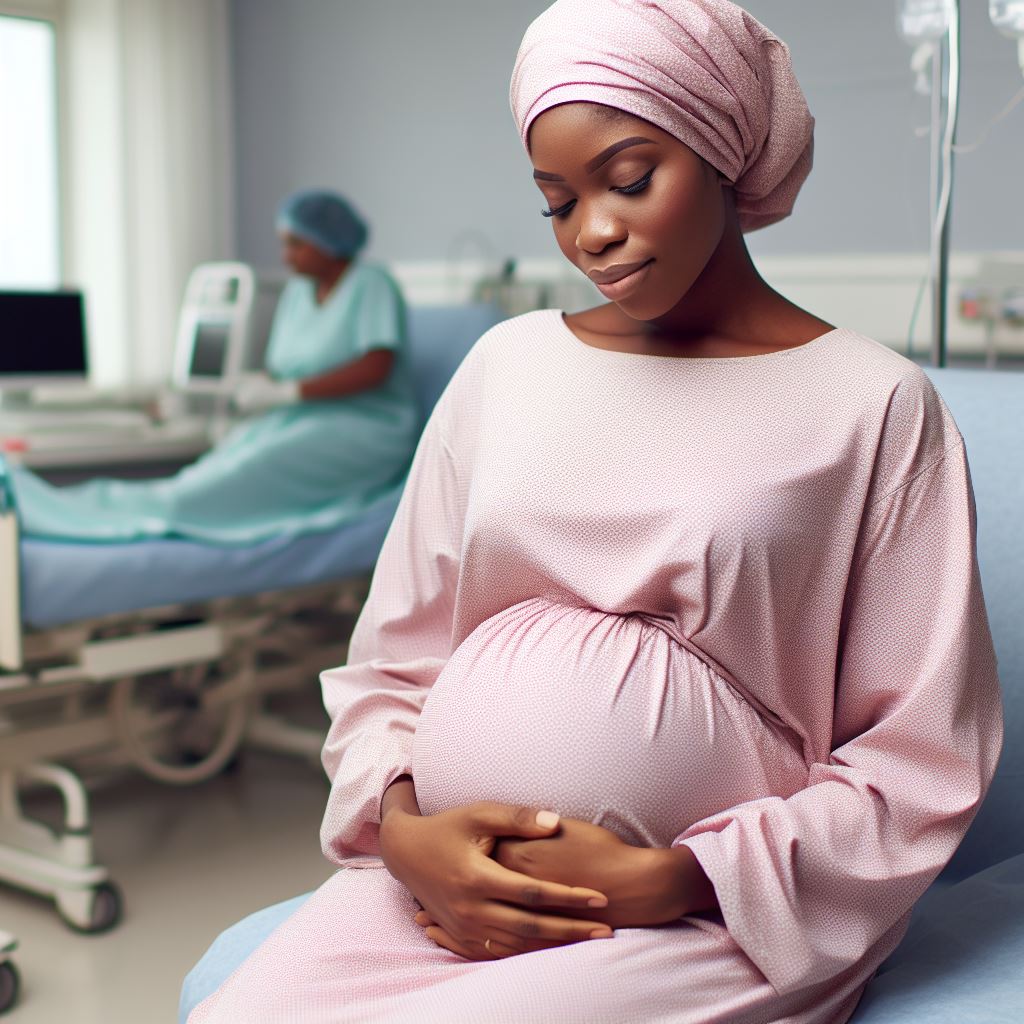Introduction
During pregnancy, the baby’s positioning in the womb plays a critical role in the well-being of both the mother and the baby.
The position of the baby can affect the progress of labor and delivery, as well as the overall health of the baby.
In Nigeria, where access to quality healthcare is limited in some areas, it is even more important to understand and promote proper baby positioning.
Improper positioning can increase the risk of complications during childbirth, such as prolonged labor, breech presentation, or even the need for a cesarean section.
This blog post aims to educate and raise awareness about the significance of baby’s positioning in Nigeria.
By providing valuable information, expectant mothers, their families, and healthcare providers can work together to ensure the best outcome for both mother and baby.
Topics covered in this blog post will include the different positions a baby can assume in the womb, the effect of positioning on labor and delivery, and techniques that can help encourage optimal baby positioning.
Additionally, tips for maintaining a healthy pregnancy and reducing the risk of complications will be discussed.
By understanding the importance of baby’s positioning and taking the necessary steps to promote it, expectant mothers in Nigeria can increase their chances of having a positive childbirth experience and a healthy baby.
Baby’s Positioning in Weeks 25-28
The baby’s positioning at this stage
During weeks 25-28, the baby starts to settle into a particular position inside the mother’s womb.
Common positions and their significance
- Head-down position: This is the ideal position for the baby as it prepares for birth.
- Breech position: In this position, the baby’s buttocks or feet are positioned to come out first.
- Transverse position: The baby lies sideways in the uterus, which may require medical intervention for delivery.
Factors influencing baby’s positioning
- Uterine space: Limited space inside the uterus can limit the baby’s movement and affect their positioning.
- Placenta location: The position of the placenta can influence how the baby settles inside the womb.
- Previous pregnancies and deliveries: Previous experiences may affect the baby’s positioning in subsequent pregnancies.
- Maternal posture and daily activities: How the mother sits, stands, and moves can impact the baby’s position.
- Medical conditions: Certain medical conditions may cause the baby to be positioned differently.
Importance of knowing baby’s position
Knowing the baby’s position is crucial for healthcare providers to monitor the progress of the pregnancy and plan for a safe delivery.
It helps in identifying any potential complications and preparing for possible interventions if needed.
Additionally, understanding the baby’s position allows the mother to be more proactive in adopting postures and exercises that encourage optimal positioning for the baby.
Read: Week 25: Baby’s Sleeping Pattern
Techniques for Optimal Baby Positioning in Nigeria
As expectant mothers in Nigeria progress through weeks 25 to 28 of pregnancy, ensuring the optimal positioning of the baby becomes paramount for a smooth and healthy childbirth experience.
Parenting Made Just for You
Get personalized Parenting Solutions tailored to your child’s needs. Transform your parenting journey with expert guidance in 1-3 days.
Get StartedEmbracing a holistic approach, various techniques can be employed to encourage the baby to assume the most favorable position for delivery.
Prenatal exercises and stretches
Engaging in prenatal exercises and stretches is vital in promoting flexibility and strength.
Activities such as pelvic tilts, squats, and tailor sitting help align the baby into the ideal head-down position.
These exercises not only contribute to the well-being of the mother but also encourage the baby to settle into the pelvis correctly.
Proper posture and body alignment
Maintaining proper posture and body alignment is crucial in preventing the baby from adopting a breech or posterior position.
Ergonomic practices, such as sitting on a birthing ball and avoiding prolonged periods of slouching, contribute to optimal fetal alignment.
Using positional techniques like forward-leaning inversion
Forward-leaning inversion is a technique that involves assuming an inclined position to encourage the baby to move into the anterior position.
This simple yet effective maneuver can be easily incorporated into a daily routine.
Utilizing birthing aids and tools
- Birth balls: These large, inflatable balls provide a comfortable surface for sitting and gentle exercises. They facilitate pelvic mobility, encouraging the baby to descend into the pelvis.
- Rebozo: A traditional Mexican shawl, the rebozo, can be used in various ways to help adjust the baby’s position gently. Techniques like sifting and rocking with a rebozo aid in optimal fetal alignment.
- Chiropractic adjustments: Professional chiropractic care can assist in aligning the spine and pelvis, creating an environment conducive to optimal baby positioning.
- Acupuncture and acupressure: Traditional practices like acupuncture and acupressure can promote balance and harmony in the body, potentially influencing the baby’s positioning.
Seeking professional help and advice from healthcare providers
Regular consultations with healthcare providers ensure that mothers receive personalized guidance based on their unique circumstances.
Professionals can offer valuable insights and monitor the baby’s positioning, suggesting adjustments as needed.
In fact, adopting a combination of these techniques empowers expectant mothers in Nigeria to actively participate in ensuring the optimal positioning of their babies.
By incorporating these practices into their routine and seeking professional guidance, mothers can enhance their chances of a positive birthing experience.
Read: Week 24: Baby’s Viability and Growth
Tips for Comfort and Optimal Positioning in Nigeria
In the vibrant journey of pregnancy, weeks 25-28 mark a crucial period for both mother and baby.
Unveil the Perfect Name that Tells Your Family's Story
Let us help you find a name that embodies your family's values, traditions, and dreams. Our personalized consultation weaves cultural insights to create a name that's uniquely yours.
Get StartedEnsuring the optimal positioning of the baby is essential for a smooth delivery.
Here are some tips to create a comfortable environment and promote ideal positioning in the Nigerian context.
Creating a Comfortable Environment for Baby’s Movement
Nigeria’s warm climate demands careful attention to the surroundings.
Ensure the living space is well-ventilated and cool.
Use light, breathable fabrics for clothing and bedding.
Provide comfortable seating and sleeping arrangements that support the natural movements of the baby.
This encourages optimal positioning for delivery and contributes to the overall well-being of both mother and child.
Practicing Good Nutrition and Hydration
A diet rich in locally available nutrients is vital during this stage.
Emphasize the consumption of fresh fruits, vegetables, and traditional Nigerian staples to support the baby’s growth.
Adequate hydration is equally important, especially in a climate where dehydration is a concern.
Traditional drinks like zobo and kunu can add both flavor and hydration to the diet.
Prenatal Massages to Relax the Pelvic Area
Traditional massages tailored to the needs of pregnant women can be beneficial.
Seek the services of experienced practitioners who understand the nuances of prenatal care.
These massages not only alleviate stress but also focus on the pelvic area, promoting relaxation and flexibility that aids in optimal baby positioning.
Avoiding Activities and Positions that Restrict Movement
Incorporate habits that discourage prolonged sitting or standing.
Encourage short breaks for gentle stretches and walks.
Traditional practices such as the Yoruba “Iponri” (gentle exercise) can be beneficial.
Avoid activities that might compress the baby’s space, fostering a more natural positioning for childbirth.
Regularly Monitoring Fetal Movements
Stay attuned to your baby’s movements.
Regular monitoring allows you to detect any changes or anomalies promptly.
Traditional practices like keeping a kick count journal can be integrated into modern monitoring techniques.
If there’s a noticeable decrease in fetal movements, seek prompt medical attention.
In the unique context of Nigeria, combining modern medical advice with traditional practices ensures a holistic approach to comfort and optimal positioning during weeks 25-28 of pregnancy.
By embracing these tips, mothers can nurture a healthy environment for their growing babies, paving the way for a smooth and joyous delivery.
Read: Week 23: Preparing for Glucose Test

Potential Complications and When to Seek Medical Assistance
Signs that indicate a potential issue with baby’s positioning
- Decreased fetal movements or sudden decrease in the frequency of kicks.
- Consistent pain or discomfort in the lower abdomen or pelvic area.
- Difficulty breathing or shortness of breath.
- Inability to lie comfortably on one side due to baby’s movements.
- Visible protrusion or bulge in the abdomen, indicating an unusual position.
Importance of regular prenatal check-ups
- Regular prenatal check-ups allow healthcare providers to monitor the baby’s growth and positioning.
- During these check-ups, the healthcare provider can detect any potential complications early on.
- Regular check-ups also provide an opportunity for the expectant mother to discuss any concerns or discomfort she may be experiencing.
- Healthcare providers can provide necessary guidance and make appropriate referrals if needed.
- These check-ups contribute to ensuring a healthy pregnancy and safe delivery for both the mother and the baby.
When to seek medical help and what to expect
- If any signs or symptoms of an issue with baby’s positioning are experienced, it is important to seek medical help promptly.
- Healthcare providers may recommend an ultrasound or other diagnostic tests to assess the baby’s position accurately.
- Depending on the findings, the healthcare provider may suggest certain exercises or positions to encourage optimal fetal positioning.
- In some cases, medical intervention such as external cephalic version (ECV) or cesarean section may be necessary to correct the positioning.
- It is essential to follow the healthcare provider’s advice and guidance to ensure the best possible outcome for both the mother and the baby.
However, in some cases, medical intervention such as external cephalic version (ECV) or cesarean section may be necessary to correct the positioning.
It is essential to follow the healthcare provider’s advice and guidance throughout the process to ensure the best possible outcome for both the mother and the baby.
In short, recognizing the signs of potential complications with the baby’s positioning is vital for expectant mothers.
Regular prenatal check-ups allow healthcare providers to monitor the baby’s growth and detect any issues early on.
Seeking medical help promptly if any signs or symptoms arise is crucial.
By following the healthcare provider’s recommendations, expectant mothers can increase the chances of a safe and healthy delivery for both themselves and their babies.
Read: Week 22: Baby’s Hair & Skin Develop
Conclusion
The positioning of the baby during pregnancy is crucial for a safe and smooth delivery.
It can greatly impact the mother’s comfort level and the baby’s overall health.
By ensuring the baby is in the optimal position, the chances of a successful natural delivery increase significantly.
Throughout weeks 25-28 of pregnancy, there are various techniques that can be tried to encourage the baby to assume the best position.
These can include exercises, proper posture, and using tools like birthing balls or pillows.
It is important for expectant mothers to stay active and maintain a healthy lifestyle to promote good positioning for the baby.
However, it is vital for pregnant women to consult with healthcare providers for guidance and support.
They can provide personalized advice and suggest specific techniques based on individual circumstances.
Regular check-ups and discussions with healthcare professionals ensure the mother and baby’s well-being throughout the pregnancy journey.
Remember, the baby’s positioning is not completely within our control, but it is worth making an effort to try different techniques.
Ultimately, the goal is to create a comfortable and safe environment for the baby’s development and delivery.
With the right mindset and support from healthcare providers, expectant mothers can increase their chances of experiencing a positive birthing experience.




